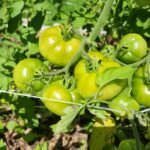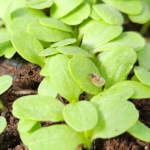Are you a veggie lover looking to grow your own carrots but don’t know where to start? Fear not! We’ve got you covered with some essential tips and tricks to help you grow juicy and delicious carrots in your own backyard.
This post contains affiliate links. If you use these links to buy something we may earn a commission. Thanks.
Carrots are one of the easiest and most satisfying vegetables to grow, especially for beginners. Whether you’re planting in raised beds, containers, or a garden plot, learning how to grow carrots successfully starts with the right soil, timing, and care.
What Kind Of Carrots Should I Grow?
Carrots are a popular root vegetable that come in many different shapes, colours, and sizes. The type of carrot seed you choose to plant can have a big impact on the final product, so it’s important to understand the different types of carrot seeds available. Here are some of the most common types:

When choosing carrot seeds, it’s important to consider your growing conditions, as well as your taste preferences. Some varieties may be better suited to certain climates or soil types, while others may have a sweeter or spicier flavor profile. With so many different types of carrot seeds to choose from, it’s easy to find the perfect variety to suit your needs.
🥕 Common Carrot Varieties
- Imperator: Imperator carrots are long, slender carrots that are typically around 8-10 inches in length. They have a sweet, mild flavor and are commonly used in salads, soups, and stews. Imperator carrots can be a bit finicky to grow, as they require deep, loose soil to develop properly.
- Nantes: Nantes carrots are a popular choice for home gardeners, as they are relatively easy to grow and have a sweet, crisp flavor. They are shorter and thicker than Imperator carrots, typically around 6-7 inches in length. Nantes carrots are great for snacking and can also be used in cooked dishes. This is our personal favourite for eating right out of the garden.
- Danvers: Danvers carrots are a classic variety that have been around since the 19th century. They are a bit wider and shorter than Imperator and Nantes carrots, with a tapered shape and a sweet, crunchy flavor. Danvers carrots are great for juicing and can also be roasted, steamed, or sauteed. Danvers are also one of the more heat tolerant carrots, and grow well in clay soils.
- Chantenay: Chantenay carrots are a stubbier variety, with a short, thick shape that makes them easy to grow in shallow soil. They have a slightly spicy, earthy flavor and are commonly used in stews, soups, and roasted dishes.
- Miniature: Miniature carrots are a fun variety that come in many different colours, including orange, yellow, purple, and even white. They are small and thin, typically only a few inches in length, and have a sweet, mild flavor. Miniature carrots are great for snacking and can also be used in salads and other dishes for a pop of colour.

How To Start Carrot Seeds?
First things first, choose a location that receives at least six hours of sunlight a day. Carrots thrive in well-draining soil with a pH level between 6.0 and 6.8, so make sure you prepare the soil accordingly. We use this soil tester to make sure our pH balance is where it needs to be. You can also add some compost to the soil to enrich it and improve the drainage.
Next, it’s time to sow the seeds. There are two main ways gardener will start their carrot seeds, direct sowing, and using seed tape.
Direct Sowing: Direct sowing involves planting carrot seeds directly into the soil where they will grow. To direct sow carrot seeds, prepare the soil by loosening it to a depth of at least 12 inches and removing any rocks or debris. Then, create shallow furrows in the soil and plant the seeds 1/4 inch deep. Water the seeds gently and keep the soil moist until the seedlings emerge.
Seed Tape: Seed tape is a convenient and easy way to plant carrot seeds, especially for gardeners with limited space or time. Seed tape is a strip of paper with carrot seeds perfectly spaced, attached to it.
To use seed tape, simply lay the tape on top of the soil and cover it with a thin layer of soil. Water the soil gently and keep it moist until the seedlings emerge. A common household item many gardeners use for seed tape is toilet paper. Simply space your carrot seeds in the middle of the paper at the desired spacing, fold the paper over and lightly wet it. Boom, it’s ready for the garden.

How To Care For Carrot Plants?
Should You Thin Carrots?
Thinning carrot seedlings is an important step in the growing process, as it helps to ensure that the remaining plants have enough space to develop properly. Once carrot seedlings have germinated and started to grow, you’ll need to thin them out by removing some of the plants.
To do this, wait until the seedlings have grown to around 2-3 inches tall and then carefully pull out the weaker plants, leaving only the healthiest and most vigorous ones. Ideally, you want to leave around 2-4 inches of space between each remaining plant, depending on the variety of carrot.
Thinning should be done in the early morning or late afternoon, when the plants are less likely to be stressed by the heat of the day. Thinning carrots can be a bit time-consuming, but it’s an important step that can help to ensure a healthy and bountiful harvest.
How Much Water Do Carrots Need?
As your carrot plants grow, make sure to keep the soil consistently moist but not waterlogged. Over watering can lead to root rot, so be careful not to overdo it. You can also add a layer of mulch to the soil to help retain moisture and prevent weeds from sprouting.
What Are Common Carrots Pests?
Now, let’s talk about pests and diseases. Carrots are relatively easy to grow, but they can be susceptible to certain pests and diseases, such as carrot rust flies and fungal infections. To prevent these problems, consider planting companion plants such as onions, leeks, or chives, which can help repel pests and deter diseases.
How To Harvest Carrots?

Harvesting your carrots is the best part! Carrots are ready to be picked when the top of the root is around 1 inch in diameter. Simply loosen the soil around the root with a garden fork, gently pull the carrot out of the ground, and voila! Fresh, homegrown carrots ready to be eaten.
Get every new article directly in your inbox.
Frequently Asked Questions About Growing Carrots
Q: How long does it take to grow carrots?
A: Most carrot varieties are ready to harvest in 60 to 80 days. Baby carrots can be harvested as early as 30 days for a sweet snack.
Q: Why are my carrots short and stubby?
A: Compacted soil or rocks can restrict root growth. Make sure your soil is loose and free of debris for long, straight carrots.
Q: Can I grow carrots in containers?
A: Absolutely! Choose a deep container (at least 12 inches) and a shorter carrot variety like Chantenay or Miniature.
Q: Do carrots need full sun?
A: Yes. Carrots grow best with at least 6 hours of sunlight per day.
Q: Why aren’t my carrot seeds sprouting?
A: Carrot seeds can be slow to germinate. Make sure the soil is consistently moist and avoid letting it dry out during germination.
Q: Can I plant carrot seeds close together?
A: Yes, but be sure to thin them once they sprout to prevent overcrowding, which can lead to misshapen or underdeveloped roots.
Ready To Grow?
We hope this guide has given you the confidence to start your own carrot patch! Growing carrots is a fun and rewarding experience for gardeners of all skill levels. With a little patience and the right tips, you’ll have sweet, crunchy carrots straight from your garden in no time.
If you found this helpful, check out our other growing guides, seed-saving tips, and recipes. Got a carrot-growing hack or question? Drop it in the comments—we love learning from our readers!





